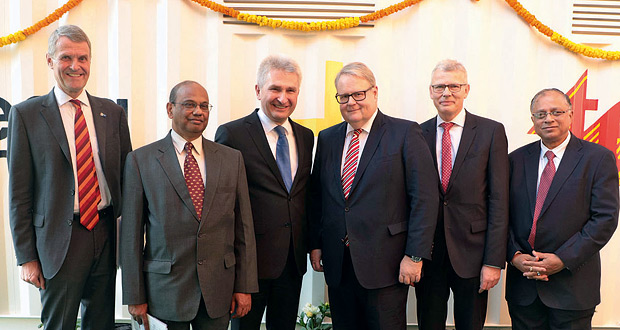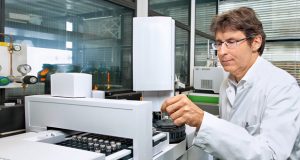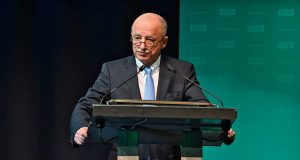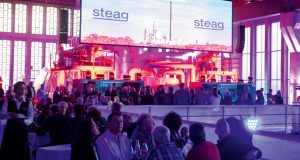In India, a population of more than 1.3 bn combined with strong economic growth are creating a huge demand for goods, services and raw materials. Developing the infrastructure, in particular unlimited access to electricity in rural regions, continues to pose a significant challenge. On 4th February 2019, at the invitation of STEAG GmbH, Essen/Germany, Prof. Andreas Pinkwart, Minister for Economic Affairs, Innovation, Digitalisation and Energy in North Rhine-Westphalia, went to New Delhi/India to find out how a company from North Rhine-Westphalia could contribute to this undertaking (Figure 1).
The Minister for Economic Affairs was greeted at the India Habitat Centre in the Indian capital by Joachim Rumstadt, Chair of the Executive Board at STEAG. Rumstadt presented the concept of distributed and resource-conserving electricity generation on the basis of PV technology, which STEAG in India is currently offering. Prof. Pinkwart was accompanied by a trade delegation made up of further business representatives from North Rhine-Westphalia. “Economic growth requires energy that covers a wide area reliably,” said Rumstadt in his opening speech.
Since the 1990s, the Essen-based energy producer has been represented in India by its subsidiary STEAG Energy Services (SES) and offers expertise in all areas of the energy sector. Minister Pinkwart was clearly impressed, saying “The STEAG photovoltaic container is a good example of the innovative products that can be developed by combining skills and expertise from North Rhine-Westphalia and India. I hope that a great number of entrepreneurs from North Rhine-Westphalia will recognise and make use of the opportunities India is opening up as a future market.”
SES currently employs around 1,500 members of staff in India – more than in any other country outside Germany – and has been building up a strong network and local expertise over several years. STEAG has a solid understanding of the market in India and develops its own technical solutions. Minister Pinkwart was given the opportunity to experience one of these solutions first-hand in the form of a 6 m long and 2.45 m wide overseas container – a container-based hybrid photovoltaic system which, with the addition of batteries, can reliably provide electricity for up to 24 hours a day, with or without a grid connection (Figure 2).
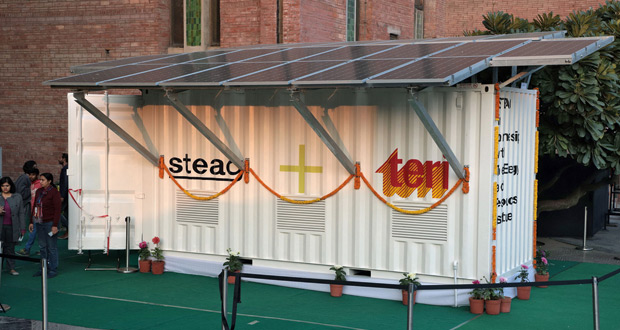
Fig. 2. Distributed and resource-conserving electricity generation on the basis of PV technology from STEAG in India. // Bild 2. Dezentrale und ressourcenschonende Stromerzeugung auf PV-Basis der STEAG in Indien. Photo/Foto: STEAG
“STEAG develops solutions for areas in India where social development and economic growth have come to a standstill,” said Rumstadt. In urban areas, the connection to the power grid is unreliable at best; some areas have no access to electricity at all. Despite the existence of plans and budgets, millions of people can still only dream of having even the most basic comforts. It was this that drove SES to develop its effective solar solution. The output is sufficient for 4 kWp.
The containers, pre-installed in India with robust technology, are quick and easy to set up and commission. First, the container acts as a transport container, which is used to transport the entire equipment. The storage space available at the destination is prepared in such a way that it can be used for a variety of functions.
STEAG will market this technical solution in India and African countries together with renowned Indian non-profit organisation “The Energy and Resources Institute (teri)”. Since the mid-1970s, the independent institute has been searching for sustainable solutions to continuously improve the living conditions of the Indian population.
STEAG handed over the first container to the Dr Nalin Singhal Memorial Foundation. It is currently being used in the North Indian state of Uttar Pradesh. In the city of Gorakhpur, the photovoltaic system is reliably supplying electricity to a project run by non-governmental organisation (NGO) URJA Energy. URJA focusses on improving the living conditions and promoting the health of women. The project in Gorakhpur gives women work producing sanitary products in a small manufacturing facility. Power cuts used to be a daily occurrence and had a major impact on productivity. The STEAG container now provides a continuous supply of electricity. This is an impressive example of how experience and initiatives from North Rhine-Westphalia, combined with local knowledge and skills, can improve the living conditions of people in poor rural regions. (STEAG/Si.)
